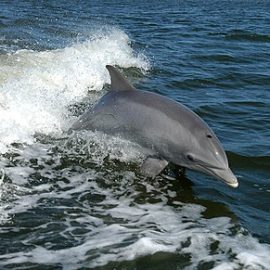
In a case of “no good deed goes unpunished”, the National Marine Fisheries Service (NMFS) says up to a third of the dolphins in Barataria Bay could be killed by the Mid-Barataria Diversion. I can only ask where was this study when the diversion was planned?
Up to a third of the bottlenose dolphins in Barataria Bay could die because of dangerously low salinity levels when the proposed Mid-Barataria Sediment Diversion is operating at its maximum capacity, according to a new study by biologists with the National Marine Fisheries Service. The diversion, part of an ambitious plan to rebuild Louisiana wetlands by mimicking the Mississippi River’s historical flooding patterns, would funnel as much as 75,000 cubic feet per second of freshwater, sediment and nutrients into the northeastern part of the bay. That’s about 12.5% of the river’s typical flow.
nola.com

A smaller proportion could survive near the barrier islands in the Gulf of Mexico notes the study, done in conjunction with an Environmental Impact Statement to be released by the Corps of Engineers later this week.
The study’s results do not include efforts the state is likely to use to reduce the diversion’s impact on salinity levels or other “minimization and stewardship” measures that might be adopted to protect marine mammals, however. The dolphin population was already significantly damaged by the BP Deepwater Horizon oil spill in 2010. In 2018, Congress ordered the U.S. Department of Commerce, parent agency of the fisheries service, to waive provisions of the Marine Mammal Protection Act that would otherwise have made it illegal to harm dolphins through the diversion. However, provisions of federal law still require the impacts of the diversion on marine mammals be weighed against the project’s benefits.
The cost of the diversion is being paid from the Deepwater fund.
The state Coastal Protection and Restoration Authority has asked that part of the diversion’s cost be paid from that fund, said executive director Bren Haase. “To use those funds, all of the federal trustee agencies, NOAA, Department of Interior, EPA and the Department of Agriculture, have to agree that this project is an appropriate means of restoring for natural resource injuries from the oil spill,” Haase said.

This is just one of the problems facing the Diversion. There is a long history of problems with the dolphins in this area which is enumerated in the article.

The problem for the dolphins is the salinity of the water.
The model’s estimates of the effects of salinity on dolphins was based on a separate peer-reviewed scientific paper that summarized both past low-salinity studies and the results of a series of workshops. That study concluded dolphins could withstand salinity conditions below 5 parts per thousand for as much as 30 days, but acute changes in salinity levels could have damaging health effects much more quickly. The technical report points out that even without the diversion, it was possible dolphins living in the bay could experience almost 13 days of salinity of below 5 ppt from water flowing into the bay during high-river periods. Under the different operating alternatives for the diversion, the longest period of exposure to low salinity increased to as much as 51 days throughout the bay, with highs of 55 days in the central and 87 days in the west region.
Another factor working against the dolphins is the water levels. Too high rather than too low.
The model results also don’t take into account the potential effects of higher water levels in future years caused by climate change effects on rainfall in the Mississippi River watershed. “Available climate prediction models suggest that precipitation during winter and spring will be significantly higher over most of North America in the coming decades, which would suggest an increasing likelihood of high-flow years”, the report said. It noted that a recent high-water event had been followed by “substantially increased dolphin mortality” in Mississippi Sound.
In short, the dolphins have more against them than for them.



